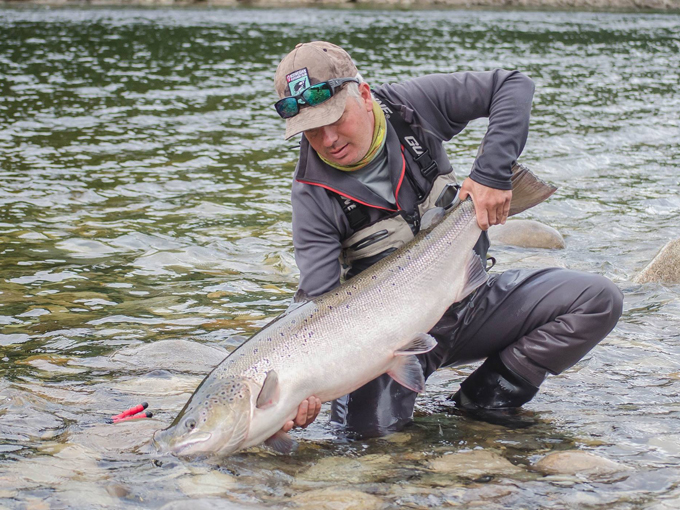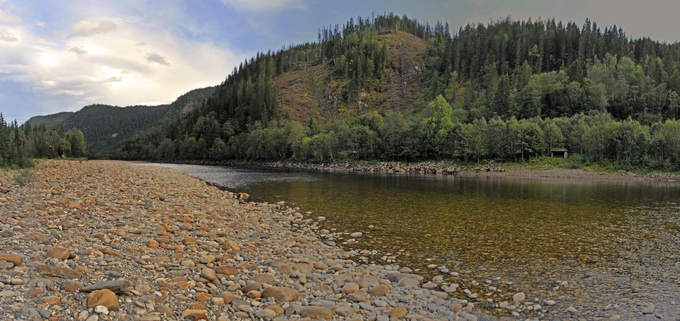B1: Langøy Pool
The Langøy Pool is infamous for its status as a big fish pool. This legend was only compounded, from the 2011 season, when the largest fish of the season was landed here weighing over 21 kg! Over the years this pool has produced many big fish and it is perhaps the pool with one of the greatest chances to hook a monster – as it always holds a number of large fish. This pool fishes well from very high-water levels all the way down to low water conditions. In general, this pool fishes well almost all season long. In the early season, fish tend to rest for a while before pushing on upstream through the long run above this pool. During the latter part of the season, this pool holds a good number of fish; which seem to congregate in the neck of the pool and in the deep hole in the middle of the beat.

B1: Langøy Pool Instructions
High water levels (above 120 m³):
The whole length of this pool fishes well and it is quite a long stretch to cover. Start fishing about 20-30 meters above the shelter on the high bank and wade out as far as you feel safe (to your hips). The current is fairly strong in the top and wading is sometimes deep, so only wade as far as you feel comfortable. The top of the Pool (in the corner) always holds fish, but fish tend to take in high water levels rather in the middle of the river or even closer to the right (our) bank. One should fish the pool step by step downstream. Make 3 to 4 steps between each cast, so as to cover the pool efficiently during your fishing session. It makes sense to fish this pool several times during a session with different lines and flies. Fish heavy full sinking lines in the beginning of the season. A hot spot is where the pool begins to widen (across from the shelter on the opposite bank). If you are able to reach the little back-eddy on the opposite bank it is really good spot if the fly is able to swing into the main current. The pool slows down here in the middle part and in high water fish seem to like to rest here. But remember: in the first pass through the pool in high water- make short casts and fish close to our bank. No need to wade deeper than to your knees – as the fish tend to lie very close to our bank, especially in the middle part and lower part of the pool, and where it begins to speed up towards Renna Pool (Beat B2- the beat below). For all high-water, situations use big flies – typical June patterns!
Medium water levels (120 m³ down to 40 m³):
The pool continues to fish equally well in medium water levels. As the water level drops, simply fish through with lighter lines such as medium sinking lines, intermediate lines, or a floating line with a sink tip. Later in the season a full floater can be a good choice. As the level drops, the hot spot becomes concentrated to the top 3rd of the pool- but fishing through the entire pool is still worthwhile. Make big steps in between each cast, and rather fish the pool several times with different line and fly combinations. There are many resident fish in this pool, and they need to be surprised by the fly- rather than watching a slow-moving fly approaching steadily- which may put them down or spook them. Medium sized flies should be used, and in the darker periods of the day a big Sunray Shadow is always a good choice.
Low water levels (below 40 m³):
The top of the beat is now really good! Start fishing almost in the connection run above the start of the pool (a way above the shelter on the high bank on our side). Wade in where the water is fast and cast as close to the opposite bank as possible. The fish tend to hold close to the opposite bank in low water and strikes are common in the first 3rd of the swing, sometimes very close to the other bank along the rocks. Lines for low water should be floating or floating with a sink tip or intermediate tip. Smaller flies are now the best choice. In the later season, “shrimpy” patterns, a heavy Francis (Black or Red) or even a skated or dry fly are worth a try. The middle part might begin to fish too slow in really low water, but the last third of the pool speeds up again and some nice rocks in the middle seem to be where fish rest when they enter into the pool from Beat B2. Especially in the evenings the lower part can be very good. In daytime one should concentrate on the top of the pool.







